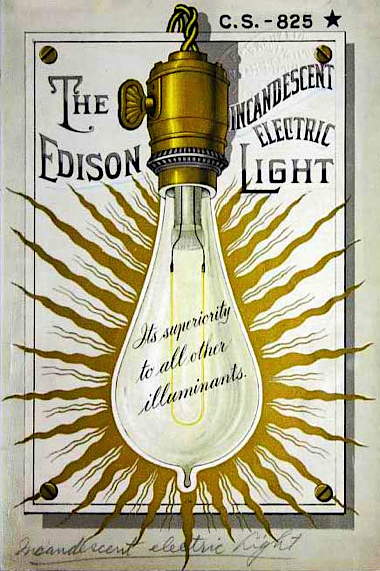« Give up on the half-way house of “dialogue” and “dialectic”: Christ is all or nothing. | Main | Conservatives are useless, cowardly failures. »
July 17, 2015
Let There Be Light Bulbs: How Incandescents Became the Icons of Innovation

The desire for incandescent lighting resulted in the creation of America’s electric grid, which improved communication, health care, manufacturing, transportation, and education. Accessible electricity also made every subsequent tech boom possible, paving the way for computers and the Internet. The lowly light bulb’s profound impact turned it into the universal symbol for innovation—yet despite the bulb’s storied legacy and Thomas Edison’s near-mythical status, for most people, that leap from fickle flame to unwavering electric light is vague at best. Even as antique-style Edison bulbs proliferate in trendy bars and restaurants, most of us know next to nothing about this revolutionary little lamp, the details of its delicate design hidden in shadow. | Collectors Weekly
Posted by gerardvanderleun at July 17, 2015 6:27 PM. This is an entry on the sideblog of American Digest: Check it out.
Your Say
I buy incandescents in bulk on Amazon and store them in the basement. Do the math on those new-fangled things. Besides keeping you in the dark until they are of a mind to light up, they also require amortization of their high prices over many years. So, if you're planning to sell your house in, say, five years, you're buying lightbulbs for someone else.
Posted by: tkirk ![[TypeKey Profile Page]](http://americandigest.org/sidelines/nav-commenters.gif) at July 18, 2015 6:01 AM
at July 18, 2015 6:01 AM
With that perspective, our whole house was bought for someone else. Anyway, I prefer the color of light that is cast from the new "warm" bulbs over the yellow of the old ones.
One of the 2 bathroom fixtures kept blowing the new bulbs, about every month or so, so I replaced the fixture last year and no more blown bulbs.
Posted by: ghostsniper ![[TypeKey Profile Page]](http://americandigest.org/sidelines/nav-commenters.gif) at July 18, 2015 6:33 AM
at July 18, 2015 6:33 AM
Let's clear something up: the fixture is called a "light fixture" and what we put in it is called a "lamp" not a bulb. Bulbs are for tulips.
Soon we will have to have a permit to carry incandescent lamps. Testing, licensing, photos, the whole damn cheese;
There will be restrictions on high-capacity light fixtures;
Your doctor, minister, next door neighbor will be informed of your possession;
Drive-by lightings will occur;
Military bases will be incandescently lighted;
Slogans like "lamps don't light, people light" and "... pry my lamp from my cold dead hands" will be popular;
The NLA will solicit money from its members to elect lamp-friendly politicians;
The neo-Luddites will be found in airports giving out candles.
Posted by: chasmatic ![[TypeKey Profile Page]](http://americandigest.org/sidelines/nav-commenters.gif) at July 18, 2015 6:39 AM
at July 18, 2015 6:39 AM
That socket (correct me if that's the wrong term chas) more resembles today's sockets than the lamp resembles today's lamps.
Posted by: BillH ![[TypeKey Profile Page]](http://americandigest.org/sidelines/nav-commenters.gif) at July 18, 2015 8:03 AM
at July 18, 2015 8:03 AM
Bill: yes the socket is that which receives the Edison-base lamp.
I reckon common usage is why most folks call 'em light bulbs.
I was an electrician for forty-four years until cancer pulled me from the game. I get too fussy sometimes; I didn't intend coming across all expert and know-it-all.
Posted by: chasmatic ![[TypeKey Profile Page]](http://americandigest.org/sidelines/nav-commenters.gif) at July 19, 2015 12:13 AM
at July 19, 2015 12:13 AM
As with everything else, most of what people know is just plain wrong.
The first electric lamp was invented by an Englishman, Humphrey Davy. From Wiki:
The story of the light bulb begins long before Edison patented the first commercially successful bulb in 1879. In 1800, Italian inventor Alessandro Volta developed the first practical method of generating electricity, the voltaic pile. Made of alternating discs of zinc and copper — interspersed with layers of cardboards soaked in salt water — the pile conducted electricity when a copper wire was connected at either end. While actually a predecessor of the modern battery, Volta's glowing copper wire is also considered to be one of the earliest manifestations of incandescent lighting.
Not long after Volta presented his discovery of a continuous source of electricity to the Royal Society in London, an English inventor named Humphrey Davy produced the world's first electric lamp by connecting voltaic piles to charcoal electrodes. Davy's 1802 invention was known as an electric arc lamp, named for the bright arc of light emitted between its two carbon rods.
Posted by: bilejones ![[TypeKey Profile Page]](http://americandigest.org/sidelines/nav-commenters.gif) at July 19, 2015 6:07 PM
at July 19, 2015 6:07 PM
Thank you bilejones for shedding some light on this article.
Posted by: chasmatic ![[TypeKey Profile Page]](http://americandigest.org/sidelines/nav-commenters.gif) at July 19, 2015 10:36 PM
at July 19, 2015 10:36 PM
The wife prefers pink tinted bulbs for the bathrooms. At my local specialty electrical store a wonderfully politically Un-PC old fart refers to them as "complexion" bulbs.
Posted by: bilejones ![[TypeKey Profile Page]](http://americandigest.org/sidelines/nav-commenters.gif) at July 20, 2015 5:49 PM
at July 20, 2015 5:49 PM